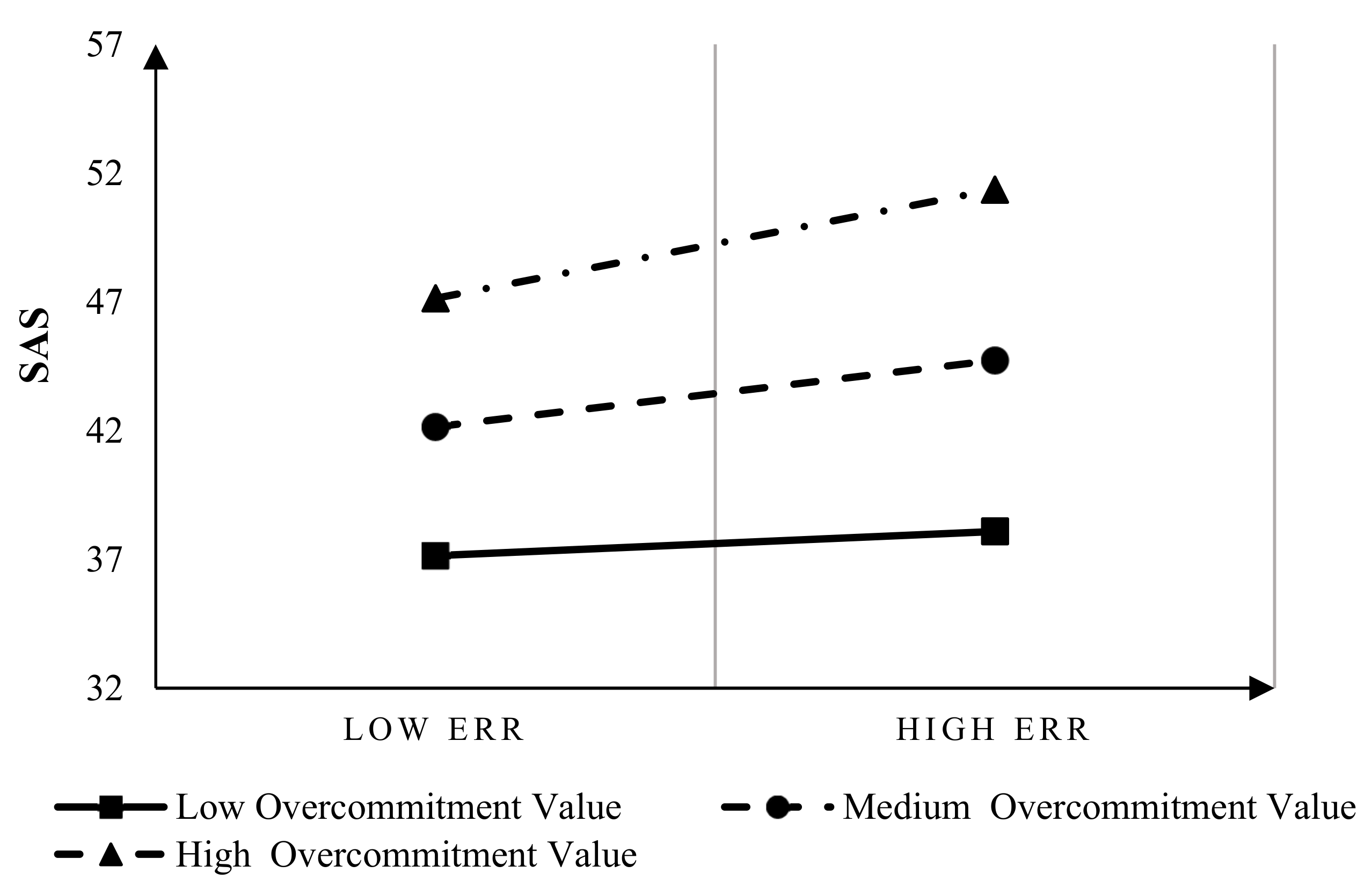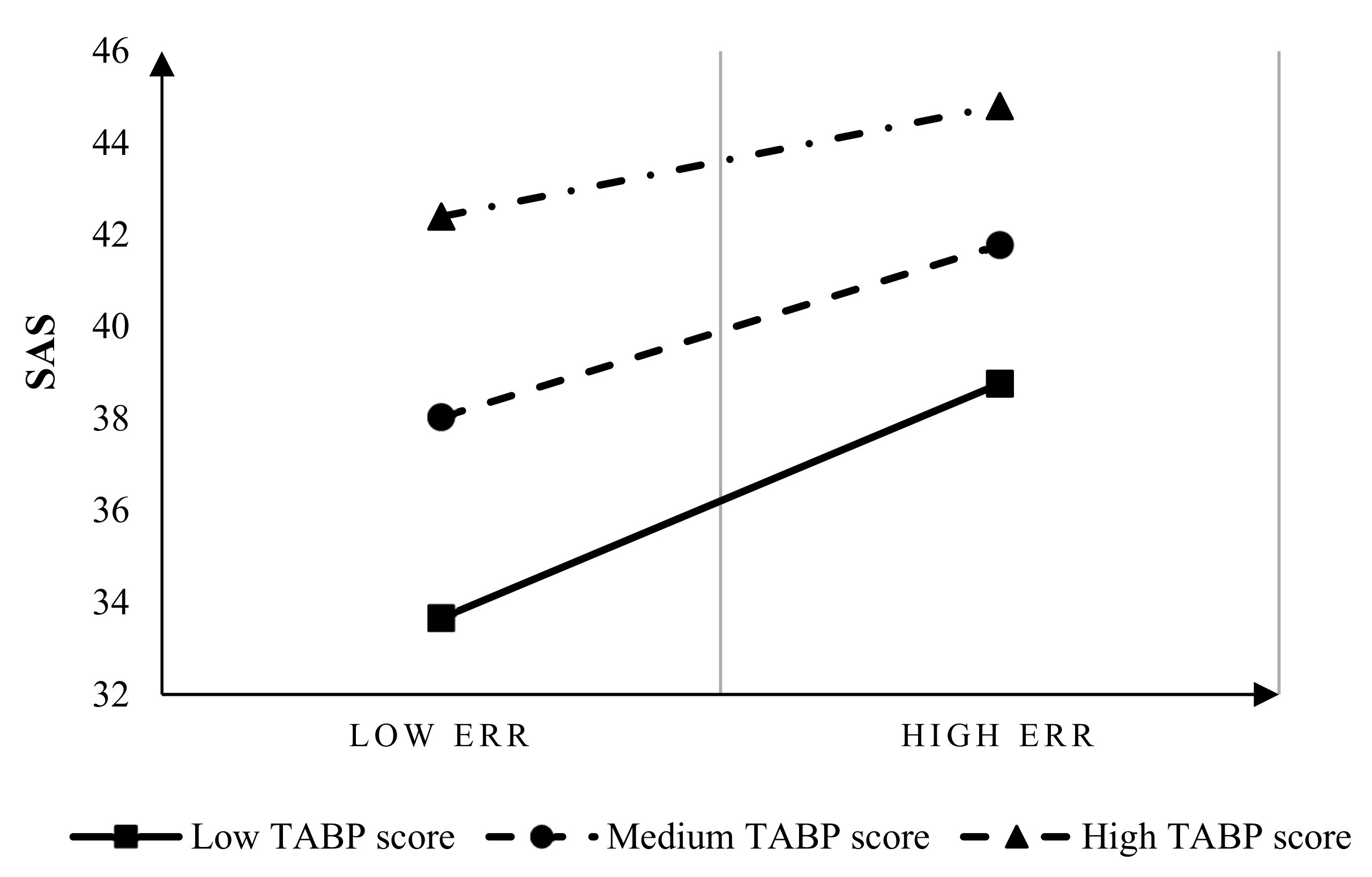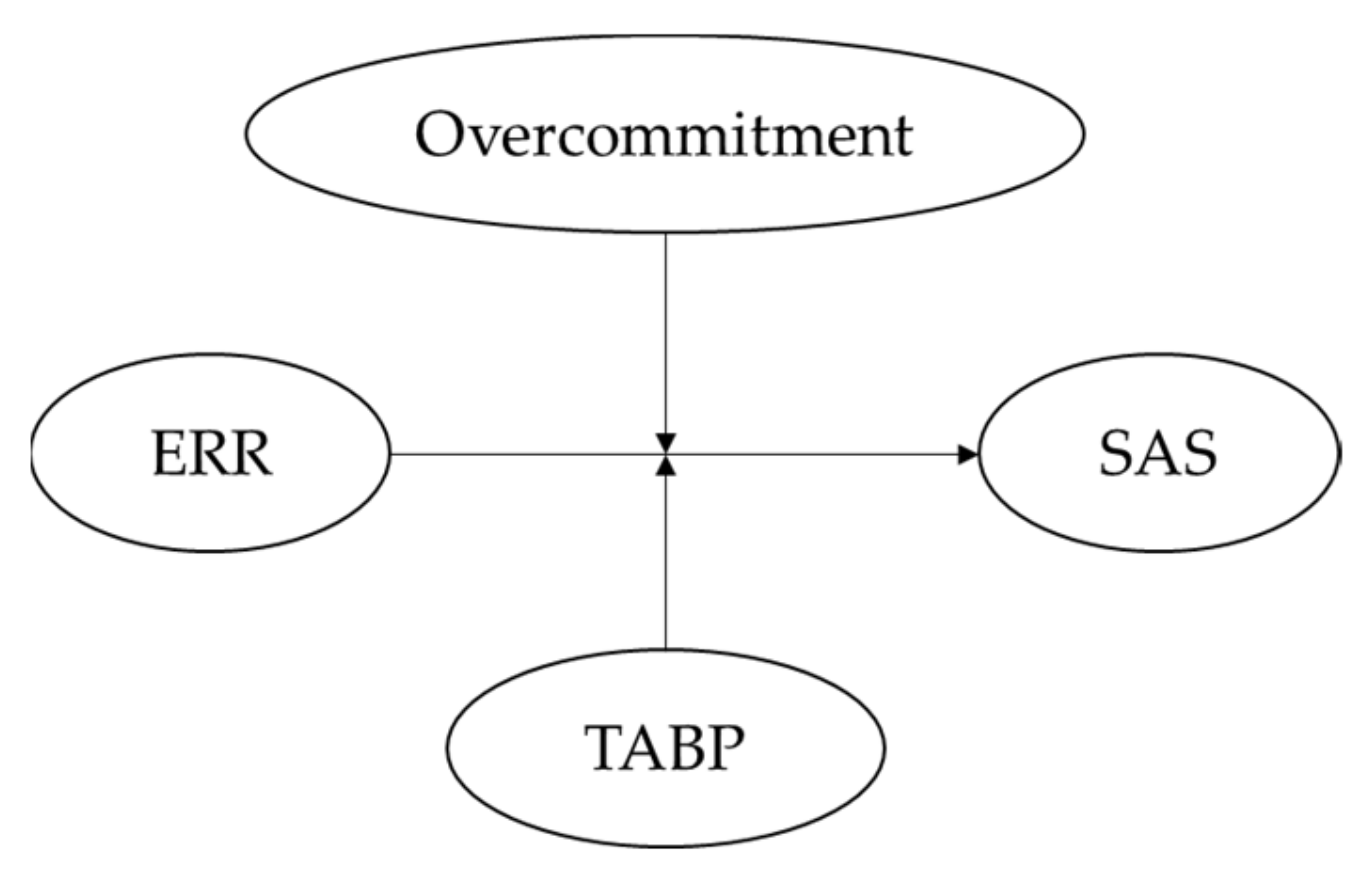The Association of Occupational Stress with Anxiety among Chinese Civil Pilots: The Moderating Role of Type A Behavior Pattern
Abstract
Highlights
- The complex relationship between the occupational stress and group anxiety symp-toms of Chinese civil aviation pilots
- Analyze the type A behavior pattern (TABP) as a mediator for occupational stress and group anxiety symptoms
- Overcommitment and TABP play moderating roles between occupational stress and anxiety.
Abstract
1. Introduction
2. Method
2.1. Participants
2.2. Measurement of Occupational Stress
2.3. Measurement of Anxiety
2.4. Measurement of Type A Behavior Pattern
2.5. Statistical Analysis
3. Results
3.1. Participant Characteristics
3.2. Descriptions of Occupational Stress, Anxiety Symptom Score and TABP Score
3.3. Correlations among Occupational Stress, Anxiety Symptom Score and TABP Score
3.4. Moderating Effect Analysis with Overcommitment/TABP Score as Moderator
4. Discussion
5. Conclusions
Author Contributions
Funding
Acknowledgments
Conflicts of Interest
References
- Leeming, D.A.; Madden, K.W.; Marlan, S. Encyclopedia of Psychology and Religion; Springer: New York, NY, USA, 2014; ISBN 1461460867. [Google Scholar]
- Spitzer, R.L.; Spitzer, R.L.; Md, K.K.; Williams, J.B.W. Diagnostic and Statistical Manual of Mental Disorders, 3rd ed.; American Psychiatric Association: Washington, DC, USA, 1980. [Google Scholar]
- Sun, W.; Fu, J.; Chang, Y.; Wang, L. Epidemiological Study on Risk Factors for Anxiety Disorder among Chinese Doctors. J. Occup. Health 2012, 54, 1–8. [Google Scholar] [CrossRef] [PubMed]
- Ruitenburg, M.M.; Frings-Dresen, M.H.; Sluiter, J.K. The Prevalence of Common Mental Disorders among Hospital Physicians and Their Association with Self-Reported Work Ability: A Cross-Sectional Study. BMC Health Serv. Res. 2012, 12, 292. [Google Scholar] [CrossRef] [PubMed]
- Picano, J.J. An Empirical Assessment of Stress-Coping Styles in Military Pilots. Aviat. Space Environ. Med. 1990, 61, 356–360. [Google Scholar] [PubMed]
- DiGiacomo, M.; Adamson, B. Coping with Stress in the Workplace: Implications for New Health Professionals. J. Allied Health 2001, 30, 106–111. [Google Scholar] [PubMed]
- Mark, G.; Smith, A.P. Occupational Stress, Job Characteristics, Coping, and the Mental Health of Nurses. Br. J. Health Psychol. 2012, 17, 505–521. [Google Scholar] [CrossRef]
- Nakao, M. Work-Related Stress and Psychosomatic Medicine. BioPsychoSoc. Med. 2010, 4, 4. [Google Scholar] [CrossRef] [PubMed]
- Ding, Y.; Qu, J.; Yu, X.; Wang, S. The Mediating Effects of Burnout on the Relationship between Anxiety Symptoms and Occupational Stress among Community Healthcare Workers in China: A Cross-Sectional Study. PLoS ONE 2014, 9, e107130. [Google Scholar] [CrossRef] [PubMed]
- Friedman, M.; Rosenman, R.H. Overt behavior pattern in coronary disease: Detection of overt behavior pattern a in patients with coronary disease by a new psychophysiological procedure. JAMA 1960, 173, 1320–1325. [Google Scholar] [CrossRef]
- Suls, J.; Green, P.; Hillis, S. Emotional Reactivity to Everyday Problems, Affective Inertia, and Neuroticism. Personal. Soc. Psychol. Bull. 2016, 24, 127–136. [Google Scholar] [CrossRef]
- McGuire, F.L. Personality Factors in Highway Accidents. Hum. Factors J. Hum. Factors Ergon. Soc. 1976, 18, 433–441. [Google Scholar] [CrossRef]
- Conger, J.J.; Gaskill, H.S.; Glad, D.D.; Rainey, R.V.; Sawrey, W.L.; Turrell, E.S. Personal and interpersonal factors in motor vehicle accidents. Am. J. Psychiatry 2006, 113, 1069–1074. [Google Scholar] [CrossRef]
- Shinar, D. Aggressive Driving: The Contribution of the Drivers and the Situation. Transp. Res. Part F Traffic Psychol. Behav. 1998, 1, 137–160. [Google Scholar] [CrossRef]
- Li, J.; Yang, W.; Cho, S.I. Gender Differences in Job Strain, Effort-Reward Imbalance, and Health Functioning among Chinese Physicians. Soc. Sci. Med. 2006, 62, 1066–1077. [Google Scholar] [CrossRef] [PubMed]
- Gao, Y.Q.; Pan, B.C.; Sun, W.; Wu, H.; Wang, J.N.; Wang, L. Depressive Symptoms among Chinese Nurses: Prevalence and the Associated Factors. J. Adv. Nurs. 2012, 68, 1166–1175. [Google Scholar] [CrossRef] [PubMed]
- Liu, L.; Chang, Y.; Fu, J.; Wang, J.; Wang, L. The Mediating Role of Psychological Capital on the Association between Occupational Stress and Depressive Symptoms among Chinese Physicians: A Cross-Sectional Study. BMC Public Health 2012, 12, 219. [Google Scholar] [CrossRef] [PubMed]
- Sui, G.Y.; Hu, S.; Sun, W.; Wang, Y.; Liu, L.; Yang, X.S.; Wang, L. Prevalence and Associated Factors of Depressive Symptoms among Chinese Male Correctional Officers. Int. Arch. Occup. Environ. Health 2014, 87, 387–395. [Google Scholar] [CrossRef]
- Shen, X.; Yang, Y.L.; Wang, Y.; Liu, L.; Wang, S.; Wang, L. The Association between Occupational Stress and Depressive Symptoms and the Mediating Role of Psychological Capital among Chinese University Teachers: A Cross-Sectional Study. BMC Psychiatry 2014, 14, 329. [Google Scholar] [CrossRef] [PubMed]
- Liu, L.; Wang, L.; Chen, J. Prevalence and Associated Factors of Depressive Symptoms among Chinese Underground Coal Miners. BioMed Res. Int. 2014, 2014, 987305. [Google Scholar] [CrossRef] [PubMed]
- Zung, W.W. A Rating Instrument for Anxiety Disorders. Psychosom. J. Consult. Liaison Psychiatry 1971, 12, 371–379. [Google Scholar] [CrossRef]
- Wang, Z.; Chi, Y. Chinese Version of Zung’s Self-Rating Anxiety Scale. J. Shanghai Psychiatry 1984, 2, 73–74. [Google Scholar]
- Zhou, J.; Yang, Y.; Qiu, X.; Yang, X.; Pan, H.; Ban, B.; Qiao, Z.; Wang, L.; Wang, W. Relationship between Anxiety and Burnout among Chinese Physicians: A Moderated Mediation Model. PLoS ONE 2016, 11, e0157013. [Google Scholar] [CrossRef] [PubMed]
- Zhang, C.; Diao, W. Deficiencies of China’s General Aviation Law and Its Improvement. Korean J. Air Space Law Policy 2013, 28, 145–181. [Google Scholar]
- Xu, W. Characteristieal Features of Behavioral Types in 60 Patients with Cerebrevascular Diseases. Beijing Med. J. 1992, 4, 196–199. [Google Scholar]
- Chen, M.; Yang, Q.; Huang, Y.; Yuan, H. The Relationship between Academic Records and A-Type Behavior for the Undergraduates in Medical Universities. Chin. J. Appl. Psychol. 1994, 1, 56–58. [Google Scholar]
- Zhang, B. Psychophysiological Reaction in Cardiovascular Disease: II. A Study on the Behavior Pattern of Coronary Heart Disease Patients. Acta Psychol. Sin. 1985, 17, 314–321. [Google Scholar]
- Wang, Y.; Wei, D.; Li, W.; Qiu, J. Individual Differences in Brain Structure and Resting-State Functional Connectivity Associated with Type A Behavior Pattern. Neuroscience 2014, 272, 217–228. [Google Scholar] [CrossRef] [PubMed]
- The PROCESS Macro for SPSS, SAS, and R—PROCESS Macro for SPSS and SAS. Available online: http://processmacro.org/index.html (accessed on 22 March 2022).
- Hayes, A.F. Introduction to Mediation, Moderation, and Conditional Process Analysis: A Regression-Based Approach; Guilford publications: New York, NY, USA, 2017; ISBN 1462534651. [Google Scholar]
- Cohen, P.; West, S.G.; Aiken, L.S. Applied Multiple Regression/Correlation Analysis for the Behavioral Sciences; Psychology Press: London, UK, 2014; ISBN 1410606260. [Google Scholar]
- Yang, G.Y.; Li, G.H. Study on Mental Health Status and Education Methods of College Teachers. Mod. Prev. Med. 2008, 35, 1490–1492. [Google Scholar]
- Gao, Y.Q.; Pan, B.C.; Sun, W.; Wu, H.; Wang, J.N.; Wang, L. Anxiety Symptoms among Chinese Nurses and the Associated Factors: A Cross Sectional Study. BMC Psychiatry 2012, 12, 141. [Google Scholar] [CrossRef]






| Variables | Level | N | % |
|---|---|---|---|
| Age | ≤25 | 11 | 7.80% |
| 26–35 | 112 | 79.43% | |
| 36–45 | 14 | 9.93% | |
| ≥45 | 4 | 2.84% | |
| Marital status | Single | 57 | 40.43% |
| Married | 83 | 58.87% | |
| Other | 1 | 0.71% | |
| Education Level | Junior College | 20 | 14.18% |
| Undergraduate | 119 | 84.40% | |
| Postgraduate or above | 2 | 1.42% | |
| Years in service | 1–5 | 69 | 48.94% |
| 6–10 | 43 | 30.50% | |
| 11–15 | 16 | 11.35% | |
| ≥15 | 13 | 9.22% | |
| Position | Flying Cadet | 6 | 4.26% |
| Co-Pilot | 87 | 61.70% | |
| Trainee Pilot/Captain | 26 | 18.44% | |
| Flight Instructor | 22 | 15.60% | |
| Work status | Normal Route | 126 | 89.36% |
| Recurrent | 10 | 7.09% | |
| Modification | 5 | 3.55% |
| Scale | Measure | Items | Mean | SD |
|---|---|---|---|---|
| Occupational Stress | Extrinsic effort | 6 | 8.76 | 4.71 |
| Reward | 11 | 14.17 | 6.59 | |
| Overcommitment | 6 | 8.99 | 2.66 | |
| ERR | 17 | 1.2 | 0.61 | |
| SAS | SAS score | 20 | 41.27 | 12.36 |
| TABP | TABP score | 50 | 22.17 | 7.16 |
| Variables | Coeff | p | LLCI | ULCI | |
|---|---|---|---|---|---|
| Constant | 29.446 | 0 | 41.5561 | 67.4849 | 0.254 * |
| ERR | −5.9495 | 0.1959 | −15.0015 | 3.1025 | |
| Overcommitment | 1.0102 | 0.1384 | −0.3302 | 2.3505 | |
| ERR × Overcommitment | 1.2369 | 0.0018 | 0.2783 | 2.1956 |
| Variables | Coeff | p | LLCI | ULCI | |
|---|---|---|---|---|---|
| Constant | 13.4071 | 0 | 41.5561 | 67.4849 | 0.226 * |
| ERR | 15.8509 | 0.0028 | 5.5373 | 26.1646 | |
| TABP | 0.8735 | 0.0012 | 0.3511 | 1.3959 | |
| ERR × TABP | −0.3764 | 0.0488 | −0.7507 | −0.0021 |
| Variables | Coeff | p | LLCI | ULCI | |
|---|---|---|---|---|---|
| Constant | 29.8667 | 0.0007 | 12.8657 | 46.8676 | 0.289 * |
| ERR | −7.3565 | 0.2906 | −21.0697 | 6.3568 | |
| Overcommitment | 0.773 | 0.258 | −0.5728 | 2.1187 | |
| ERR × Overcommitment | 1.3194 | 0.008 | 0.3503 | 2.2885 | |
| TABP | 0.2926 | 0.1962 | −0.1529 | 0.738 | |
| ERR × TABP | −0.0108 | 0.9469 | −0.3316 | 0.31 |
Publisher’s Note: MDPI stays neutral with regard to jurisdictional claims in published maps and institutional affiliations. |
© 2022 by the authors. Licensee MDPI, Basel, Switzerland. This article is an open access article distributed under the terms and conditions of the Creative Commons Attribution (CC BY) license (https://creativecommons.org/licenses/by/4.0/).
Share and Cite
Wang, Y.; Guo, W.; Cheng, L.; Ji, R.; Zhou, Y.; Liu, X.; Zhao, Y.; Liu, Z.; Wang, L. The Association of Occupational Stress with Anxiety among Chinese Civil Pilots: The Moderating Role of Type A Behavior Pattern. Aerospace 2022, 9, 740. https://doi.org/10.3390/aerospace9120740
Wang Y, Guo W, Cheng L, Ji R, Zhou Y, Liu X, Zhao Y, Liu Z, Wang L. The Association of Occupational Stress with Anxiety among Chinese Civil Pilots: The Moderating Role of Type A Behavior Pattern. Aerospace. 2022; 9(12):740. https://doi.org/10.3390/aerospace9120740
Chicago/Turabian StyleWang, Yanlong, Wei Guo, Lin Cheng, Ruipeng Ji, Yizhi Zhou, Xinhua Liu, Yanzeng Zhao, Ziyu Liu, and Lijing Wang. 2022. "The Association of Occupational Stress with Anxiety among Chinese Civil Pilots: The Moderating Role of Type A Behavior Pattern" Aerospace 9, no. 12: 740. https://doi.org/10.3390/aerospace9120740
APA StyleWang, Y., Guo, W., Cheng, L., Ji, R., Zhou, Y., Liu, X., Zhao, Y., Liu, Z., & Wang, L. (2022). The Association of Occupational Stress with Anxiety among Chinese Civil Pilots: The Moderating Role of Type A Behavior Pattern. Aerospace, 9(12), 740. https://doi.org/10.3390/aerospace9120740






